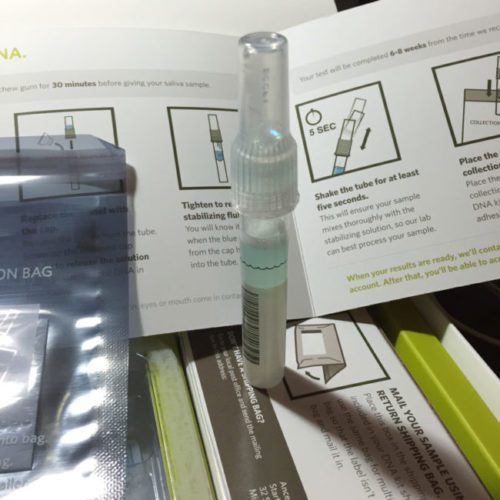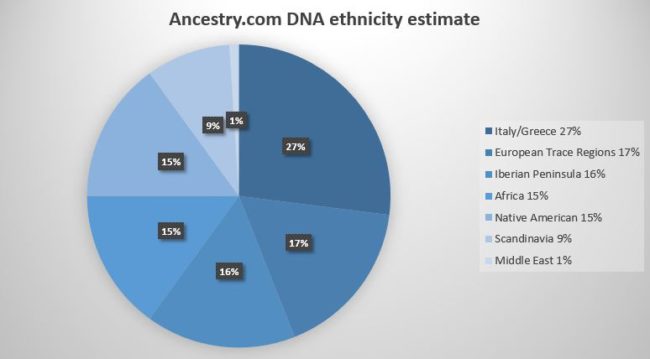I’m so excited to get the results of my Ancestry.com DNA test!
In 2007, I started dabbling in genealogy. My family came to the United States as refugees from Cuba and I knew very little about my background. My spirituality led me to my ancestors and I wanted to know more about them and my ethnic ancestry.
Over the years, I’ve learned a lot. I’ve learned about the prehistory and Spanish colonization of Cuba. As a result of this history, I came to suspect that my ethnic ancestry was made up of indigenous Cuban (Taíno), Spanish, and West African ethnicity.
In 2008, I participated in the National Geographic’s Genographic Project, a genetic anthropology study that aims to map historical human migration patterns by collecting and analyzing DNA samples from hundreds of thousands of people from around the world. This study tested my mitochondrial DNA (maternal) and I learned that I belong to haplogroup L2, a common African lineage.
I’ve also been working on the paper trail. In 2015, I learned the names of about 30 ancestors and found my grandfather’s grave. One thing I haven’t found is an immigrant. Every ancestor I’ve found so far, going back four generations, has been born in Cuba.
Most recently, I ordered the AncestryDNA test. It’s an autosomal DNA test covering both the maternal and paternal lines. It predicts genetic ethnicity estimates and identifies potential DNA matches.

It’s simple. You add your saliva to a little plastic tube, shake it to mix with a mysterious blue liquid, and return the tube in the included self-addressed, postage-paid shipping bag. Then you wait about six weeks for an email informing you that the results are available on the website.
Ancestry.com displays the results in alphabetical order so I created this pie chart to see them in terms of the percentages.

In summary, it’s 70% European, 15% African, and 15% indigenous to the Americas. That’s consistent with what I suspected, but the European breakdown was a little surprising. Let’s take a closer look.
Italy/Greece 27%
More than anything else, I’m genetically ethnic Italian/Greek? What?
This was amusing to my Greek-Australian partner who on more than one occasion has jokingly called me a wog. Is it my love of hummus and pizza? The inability to express myself without yelling and waving my arms about? My collection of Greco-Roman statues? “Wog”, by the way, is a racial or ethnic slur applied by white Australians to Greeks, Italians, Lebanese, Maltans, and so forth. Like many slurs, it is reappropriated by the people it was used to disparage.
As far as I know, I don’t have an Italian or Greek ancestor. I suspect that this percentage is the result of Spain having had Greek colonies and of Roman conquest. Italy/Greece shows up regularly in people with Spanish ancestry.
European Trace Regions 17%
What are trace regions? Ancestry.com says:
“These are regions where you seem to have just a trace amount of genetic ethnicity — there is only a small amount of evidence supporting the regions as part of your genetic ethnicity. Because both the estimated amount and the range of the estimate are small, it is possible that these regions appear by chance and are not actually part of your genetic ethnicity.”
17% is significant, I think, so it’s probably safe to assume that I’m a European mongrel, the result of genetic admixing over hundreds of years. Here’s the breakdown:
- Ireland 5%
- Europe East 4% (e.g. Poland, Slovakia, Czech Republic, Austria, Russia, Hungary, Romania, etc.)
- Great Britain 3%
- Europe West 3% (e.g. Belgium, France, Germany, Netherlands, Switzerland, etc.)
- European Jewish 2% (e.g. Poland, Belarus, Ukraine, Russia, etc.)
Ancestry.com states, “Since there is only a small amount of evidence that you have genetic ethnicity from these regions, it is possible that you may not have genetic ethnicity from them at all.”
These numbers are too small to consider without further evidence. This is where the paper trail is handy, but I haven’t found any ancestors from these regions. It’s also possible that this is going further back than any documentation I’ll ever find.
Iberian Peninsula 16%
The Iberian Peninsula refers to modern-day Spain, Portugal, Andorra, and Gibraltar. It’s a genetically diverse region and other regions commonly seen in people native to the Iberian Peninsula include – you guessed it – Italy/Greece.
I thought the percentage would be bigger, but this result does not surprise me. Cuba was colonized by Spain and it is well established that Spain is the primary source of European heritage in Cuba. In my family, I suspect my paternal great-grandfather may have immigrated from the Canary Islands.
Africa 15%
That I have African ethnicity doesn’t surprise me. It makes sense given Cuba’s history and it was confirmed in the National Geographic mtDNA test. I was expecting West African regions, particularly Nigeria, but the result was more diverse and surprising:
- Benin/Togo 6%
- Africa Southeastern Bantu 3%
- Cameroon/Congo 3%
- Mali 2%
- Africa North 1%
Benin and Togo, along with Nigeria, are Yorubaland and Ancestry.com explains:
“Benin’s largest ethnic group is the Fon (39%), followed by the Adja (15%), Yoruba (12%) and Bariba (9%). Togo’s largest ethnic groups are the Ewe (21%), Kabye (12%), Mina (3.2%) and Kotokoli (3.2%). Benin has more ethnic ties to its neighbor Nigeria; Togo has more links to Ghana. These ethnic ties are the result of long-standing kingdoms that flourished before European colonists created new borders.”
Most of the slaves that were brought to Cuba and other parts of the Caribbean were from these regions.
Native American 15%
Ancestry.com doesn’t have enough samples from indigenous people of the Americas to be able to break this down further. Cuba’s indigenous were the Taíno peoples, but my ethnic ancestry could include others groups. For example, some Apalachee from Florida fled to Cuba, or were carried as slaves. This is an area in which I have a lot of research to do.
Scandinavia 9%
 This one completely surprised me, but it shouldn’t have. Those Vikings got around, pillaging and plundering, but also trading and founding permanent settlements and colonies.
This one completely surprised me, but it shouldn’t have. Those Vikings got around, pillaging and plundering, but also trading and founding permanent settlements and colonies.
Middle East <1%
This refers to Syria, Iraq, Saudi Arabia, Jordan, Oman, Yemen, United Arab Emirates, Lebanon, Israel, and so forth. This appears as a tiny race region and Ancestry.com states that it may or may not be part of my genetic ancestry. I think this is reasonable considering migrations, the Jewish diaspora, and that the Islamic Moors of Arab and Berber descent in North Africa conquered the Iberian Peninsula in 711.
Potential DNA matches
Other than predicting your genetic ethnicity estimates, the Ancestry DNA test also identifies potential DNA matches. Some people in the Ancestry.com community think this is where the real value of the test is.

I don’t know the person pictured above, but Ancestry.com says we’re a DNA match and the chance that we’re third or fourth cousins (six to ten degrees of separation) is “Extremely High”. In other words, there’s a good chance that this Ancestry.com user, monicaquirch, and I have a common ancestor. I could contact her, ask if she wants to compare our paper trails, and see if we can help each other fill in the gaps of our family trees.
Ancestry.com identified 43 matches. monicaquirch is the closest and then they get more and more distant.
What does it all mean?
It’s insightful and it’s fun and confirms a few things I already knew. It changes very little about my sense of identity, but it does give me more to think about and explore.
If this is something you’re interested in, I encourage you to do it. I love that it lets people discover something new about themselves and that it helps demystify race as a biological classification.
There are a number of genealogical DNA tests available so be sure to do your research and understand what they provide and what they don’t/can’t tell you. I chose Ancestry.com because it has the largest sample size. People with a curiosity for genealogy often use a combination of tests and companies. This is my second test and second company and I don’t think it will be the last.
Have you ever done a genealogical DNA test? Were you surprised by the results?

